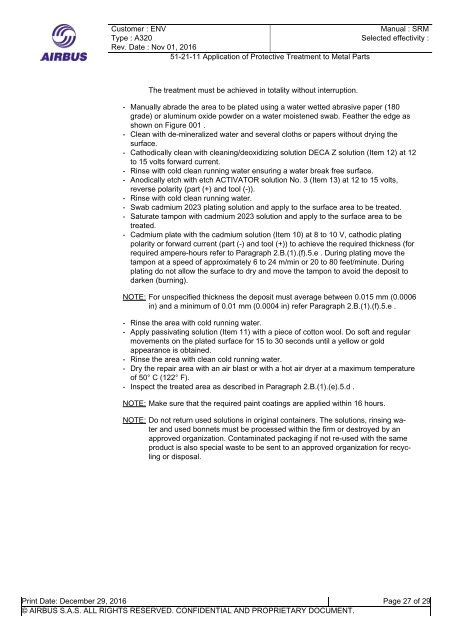Create successful ePaper yourself
Turn your PDF publications into a flip-book with our unique Google optimized e-Paper software.
Customer : ENV<br />
Type : A<strong>320</strong><br />
Rev. Date : Nov 01, 2016<br />
<strong>51</strong>-<strong>21</strong>-<strong>11</strong> Application of Protective Treatment to Metal Parts<br />
Manual : <strong>SRM</strong><br />
Selected effectivity :<br />
The treatment must be achieved in totality without interruption.<br />
- Manually abrade the area to be plated using a water wetted abrasive paper (180<br />
grade) or aluminum oxide powder on a water moistened swab. Feather the edge as<br />
shown on Figure 001 .<br />
- Clean with de-mineralized water and several cloths or papers without drying the<br />
surface.<br />
- Cathodically clean with cleaning/deoxidizing solution DECA Z solution (Item 12) at 12<br />
to 15 volts forward current.<br />
- Rinse with cold clean running water ensuring a water break free surface.<br />
- Anodically etch with etch ACTIVA<strong>TO</strong>R solution No. 3 (Item 13) at 12 to 15 volts,<br />
reverse polarity (part (+) and tool (-)).<br />
- Rinse with cold clean running water.<br />
- Swab cadmium 2023 plating solution and apply to the surface area to be treated.<br />
- Saturate tampon with cadmium 2023 solution and apply to the surface area to be<br />
treated.<br />
- Cadmium plate with the cadmium solution (Item 10) at 8 to 10 V, cathodic plating<br />
polarity or forward current (part (-) and tool (+)) to achieve the required thickness (for<br />
required ampere-hours refer to Paragraph 2.B.(1).(f).5.e . During plating move the<br />
tampon at a speed of approximately 6 to 24 m/min or 20 to 80 feet/minute. During<br />
plating do not allow the surface to dry and move the tampon to avoid the deposit to<br />
darken (burning).<br />
NOTE: For unspecified thickness the deposit must average between 0.015 mm (0.0006<br />
in) and a minimum of 0.01 mm (0.0004 in) refer Paragraph 2.B.(1).(f).5.e .<br />
- Rinse the area with cold running water.<br />
- Apply passivating solution (Item <strong>11</strong>) with a piece of cotton wool. Do soft and regular<br />
movements on the plated surface for 15 to 30 seconds until a yellow or gold<br />
appearance is obtained.<br />
- Rinse the area with clean cold running water.<br />
- Dry the repair area with an air blast or with a hot air dryer at a maximum temperature<br />
of 50° C (122° F).<br />
- Inspect the treated area as described in Paragraph 2.B.(1).(e).5.d .<br />
NOTE: Make sure that the required paint coatings are applied within 16 hours.<br />
NOTE: Do not return used solutions in original containers. The solutions, rinsing water<br />
and used bonnets must be processed within the firm or destroyed by an<br />
approved organization. Contaminated packaging if not re-used with the same<br />
product is also special waste to be sent to an approved organization for recycling<br />
or disposal.<br />
Print Date: December 29, 2016 Page 27 of 29<br />
© AIRBUS S.A.S. ALL RIGHTS RESERVED. CONFIDENTIAL AND PROPRIETARY DOCUMENT.


